1950-1959
1953 Cadillac Fleetwood
- Details
- Written by Big Block
- Category: 1950-1959
- Hits: 2271
1953 Cadillac Fleetwood
| SERIES SIXTY SPECIAL FLEETWOOD |
Eight vertical louvers on the lower rear fenders directly behind the fender breakline once again characterized the wide door Cadillac sedan. This model was also distinguished by exclusive extra-wide full-length chrome underscores and a Fleetwood insignia on the rear deck lid.
| I. D. NUMBERS |
- Serial numbers and engine numbers were again one and the same.
- They appeared on the right hand side of the crankcase above the water pump and on the right frame side bar behind the engine support.
- The first two symbols were "53" for 1953.
- The next two symbols indicated the series as follows:
- "62" = Series 62 (including Eldorado)
- "60" = Series Sixty Special Fleetwood
- "75" = Series 75 Fleetwood
- The remaining digits represented the consecutive unit number and began with 00000 for all series.
- All series had the same ending number, which would be misinterpreted if listed.
| Model Number | Body Style | Doors | Model | Seating | Factory Price | Shipping Weight | Production Total |
| 53-60 | 6019X | 4-door | Sedan | 5 | 4305 | 4337 | 20,000 |
| ENGINE |
- V-8 Overhead valves.
- Cast iron block.
- Displacement: 331 cubic inches.
- Bore and stroke: 3-15/16 x 3-5/8 inches.
- Compression ratio: 8.25:1.
- Brake horsepower: 210 at 4150 rpm
- Five main bearings
- Hydraulic valve lifters.
- Carburetors:
- with Hydra-Matic Transmission: Carter WCFB four-barrel Model 2005S - also - Rochester 4GC four-barrel Model 7005100.
- with Dynaflow Transmission: Carter WCFB four-barrel Models 2088S, 2119S, and 2119SA also - Rochester 4GC four-barrel Model 7006215.
- Note: After the Hydra-Matic plant fire approximately 19,000 Cadillac’s were sold with Buick Dynaflow transmission attachments. This was referred to as the "Twin Turbine" drive.
| ENGINE |
- V-8 Overhead valves.
- Cast iron block.
- Displacement: 331 cubic inches.
- Bore and stroke: 3-15/16 x 3-5/8 inches.
- Compression ratio: 8.25:1.
- Brake horsepower: 210 at 4150 rpm
- Five main bearings
- Hydraulic valve lifters.
- Carburetors:
- with Hydra-Matic Transmission: Carter WCFB four-barrel Model 2005S - also - Rochester 4GC four-barrel Model 7005100.
- with Dynaflow Transmission: Carter WCFB four-barrel Models 2088S, 2119S, and 2119SA also - Rochester 4GC four-barrel Model 7006215.
- Note: After the Hydra-Matic plant fire approximately 19,000 Cadillac’s were sold with Buick Dynaflow transmission attachments. This was referred to as the "Twin Turbine" drive.
| SERIES 75 FLEETWOOD |
Styling facelifts on the cars in the 75 Fleetwood line conformed to those seen on the other models. Appearance features and equipment were about the same as in previous years. Regular production models included the Imperial eight-passenger limousine with glass partition or eight-passenger sedan, both with jump seats.
| Model Number | Body Style | Doors | Model | Seating | Factory Price | Shipping Weight | Production Total |
| 53-75 | 7523X | 4-door | Sedan | 8 | 5604 | 4801 | 1,435 |
| 53-75 | 7533X | - | Imperial Sedan | 8 | 5818 | 4853 | 765 |
| 53-86 | 8680S | - | Commercial chassis | - | - | - | 2,005 |
NOTE: The commercial chassis featured a 157 inch wheelbase and was provided to makers of professional vehicles for construction of funeral cars, ambulances, etc.
| ENGINE |
- V-8 Overhead valves.
- Cast iron block.
- Displacement: 331 cubic inches.
- Bore and stroke: 3-15/16 x 3-5/8 inches.
- Compression ratio: 8.25:1.
- Brake horsepower: 210 at 4150 rpm
- Five main bearings
- Hydraulic valve lifters.
- Carburetors:
- with Hydra-Matic Transmission: Carter WCFB four-barrel Model 2005S - also - Rochester 4GC four-barrel Model 7005100.
- with Dynaflow Transmission: Carter WCFB four-barrel Models 2088S, 2119S, and 2119SA also - Rochester 4GC four-barrel Model 7006215.
- Note: After the Hydra-Matic plant fire approximately 19,000 Cadillac’s were sold with Buick Dynaflow transmission attachments. This was referred to as the "Twin Turbine" drive.
| CHASSIS |
| Feature | Series 60S | Series 75 |
| Wheelbase | 130 inches | 146-3/4 inches |
| Overall length | 224.8 inches | 236.5 inches |
| Tires | 8.00 x 15 | 8.20 x 15 |
| Rear axle ratios | 3.07:1 | 3.77:1 |
| Exhaust | Dual exhaust system standard | |
| POWERTRAIN OPTIONS |
- None available.
| CONVENIENCE OPTIONS |
- Hydra-Matic drive on Series 75 ($186).
- Heating and ventilation system ($199).
- Power steering ($177).
- Signal-seeking radio with pre-selector and antenna ($132).
- Remote control signal-seeking radio with pre-selector and antenna ($214).
- Five white sidewall tires ($48 exchange).
- Tinted E-Z-Eye glass ($46).
- Autronic Eye Automatic headlamp beam control ($53).
- Chrome wire wheels ($325).
- Air conditioning ($620).
- Other standard G.M. accessories.
| HISTORICAL |
1953 Cadillac Eldorado
- Details
- Written by Big Block
- Category: 1950-1959
- Hits: 2389
1953 Cadillac Eldorado
 Eldorado -- in proper Spanish, El Dorado-means "The Gilded One." In the lore of the ancients it was a legendary golden kingdom, a place of fabulous riches located -- or so it was believed -- high in the snow-capped mountains of what is now Colombia. Over the years, "Eldorado" thus came to represent the best of everything: opulence, wealth, the good life. So it was also a completely logical choice as the name for a stunning new convertible that arrived as Cadillac's style leader and its ultimate prestige car for 1953.
Eldorado -- in proper Spanish, El Dorado-means "The Gilded One." In the lore of the ancients it was a legendary golden kingdom, a place of fabulous riches located -- or so it was believed -- high in the snow-capped mountains of what is now Colombia. Over the years, "Eldorado" thus came to represent the best of everything: opulence, wealth, the good life. So it was also a completely logical choice as the name for a stunning new convertible that arrived as Cadillac's style leader and its ultimate prestige car for 1953. 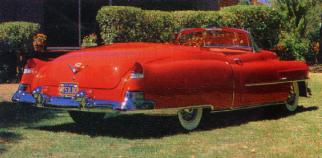 Cadillac had startled the automotive world back in 1930 with America's first sixteen-cylinder motorcar. The V-16 line never made a nickel in its 11 years of production. Chances are it wasn't intended to. It was an image-builder. And with the help of these magnificent machines, Cadillac was indeed able to elbow its way past Packard to become the country's most prestigious luxury make.
Cadillac had startled the automotive world back in 1930 with America's first sixteen-cylinder motorcar. The V-16 line never made a nickel in its 11 years of production. Chances are it wasn't intended to. It was an image-builder. And with the help of these magnificent machines, Cadillac was indeed able to elbow its way past Packard to become the country's most prestigious luxury make.
The original Eldorado can be viewed in the same light, though the image it projected was vastly different. Instead of staid, classic dignity, it had flair, e´lan, panache. But like the Sixteen, it cost the world: $7750, fully 87 percent more than the standard Series 62 convertible. Also like its distinguished Thirties forebear, it was scarce: only 532 were built in that inaugural model year.
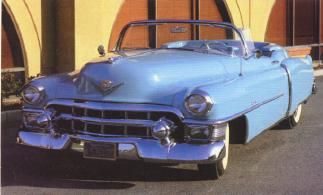
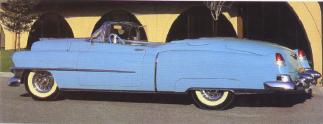
Many of us first saw the Eldorado on television. The date was January 20, 1953, and Dwight D. Eisenhower, easily the most popular hero of World War II, was being driven down Pennsylvania Avenue to his first inauguration as President of the United States Setting a jaunty tone for the new administration, our soon-to-be-anointed leader was shown in the back seat of the exotic new Cadillac we'd been reading about. (And how strange to recall a time not all that long ago when our President could greet a crowd from an open car without the need for a bulletproof barrier.) Of course, in the minds of committed car buffs the Chief Executive had been upstaged: we couldn't take our eyes off that gorgeous Eldorado, the most glamorous machine yet seen from postwar Detroit.

The first production Eldorado was inspired by a 1952 show car based on the normal Series 62 convertible as modified under the aegis of General Motors design chief Harley Earl. Along with the 1953 Chevrolet Corvette, it was the first of GM's Motorama dream machines to be offered for public sale. Among its features were the new "Panoramic" wraparound windshields harbinger of things to come -- plus a stylishly notched beltline and a flush-fitting metal cover to conceal the folded cloth top. Standing some three inches lower than its Series 62 cousin, the Eldorado had a longer, slinkier appearance, though its overall length was the same. Its interior, was upholstered in the finest leather, and a sparkling set of chromed wire wheels added a final touch of elegance. Standard equipment included radio, heater, white-sidewall tires, power steering and, of course, Hydra-Matic transmission. If there were any doubts that Cadillac reigned supreme in the prestige class, the Eldorado forever laid them to rest.
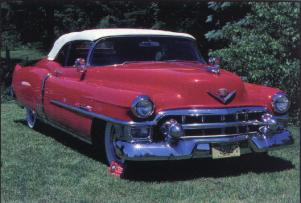
Standard equipment included Hydra-Matic drive, wraparound windshield, special cut-down doors, rich leather-and-cloth upholstery, wire wheels, white sidewall tires, fog lamps, vanity and side mirrors, metal tonneau cover and signal-seeking radio. The convertible is a certified Milestone Car. The futuristic Cadillac LeMans show car convertible was displayed in 1953 and heavily influenced the styling of the 1954 Eldorado.
Model Number | Body Style | Doors | Model | Seating | Factory Price | Shipping Weight | Production Total |
| ELDORADO SPECIAL | |||||||
| 53-62 | 6267S | 2-door | Sport Convertible Coupe | 5 | 7750 | 4799 | 532 |
NOTE: Hydraulic window lifts were standard equipment
ENGINE |
- V-8 Overhead valves.
- Cast iron block.
- Displacement: 331 cubic inches.
- Bore and stroke: 3-15/16 x 3-5/8 inches.
- Compression ratio: 8.25:1.
- Brake horsepower: 210 at 4150 rpm
- Five main bearings
- Hydraulic valve lifters.
- Carburetors:
- with Hydra-Matic Transmission: Carter WCFB four-barrel Model 2005S - also - Rochester 4GC four-barrel Model 7005100.
- with Dynaflow Transmission: Carter WCFB four-barrel Models 2088S, 2119S, and 2119SA also - Rochester 4GC four-barrel Model 7006215.
- Note: After the Hydra-Matic plant fire approximately 19,000 Cadillac’s were sold with Buick Dynaflow transmission attachments. This was referred to as the "Twin Turbine" drive.
CHASSIS |
- Wheelbase: 126 inches
- Overall length: 220.8 inches
- Tires: 8.00 x 15
- Dual exhaust system standard.
- Rear axle ratios: 3.07:1
POWERTRAIN OPTIONS |
- None available.
CONVENIENCE OPTIONS |
- Heating and ventilation system ($199).
- Power steering ($177).
- Tinted E-Z-Eye glass ($46).
- Autronic Eye Automatic headlamp beam control ($53).
- Air conditioning ($620).
- Other standard G.M. accessories.
HISTORICAL |
- Hydra-matic drive
- wraparound windshield
- special cut-down doors
- rich leather-and-cloth upholstery
- wire wheels
- white sidewall tires
- fog lamps
- vanity and side mirrors
- metal tonneau cover
- signal-seeking radio.
The Style Number 6267S Eldorado sport convertible is a certified Milestone Car. The futuristic Cadillac LeMans show car convertible was displayed this year and would heavily influence styling of the 1954 Eldorado. It has a special 270 horsepower V-8 with dual four-barrel carburetion and a fiberglass body.
HISTORICAL |
1953 Cadillac Series 62
- Details
- Written by Big Block
- Category: 1950-1959
- Hits: 2882
1953 Cadillac - Series 62
 Styling and horsepower sold cars in the Fifties, and nobody knew that better than Cadillac. Style wise, its famous tailfins debuted on the 1948 models, a design hallmark that was destined to last nearly two generations. A year later the trend-setting Series 62 Coupe de Ville hardtop bowed. Although styling changed from year to year, Cadillac carefully maintained a continuity of design so that even though the car always looked "new," there could never be any mistake that it was indeed "The Standard of the World."
Styling and horsepower sold cars in the Fifties, and nobody knew that better than Cadillac. Style wise, its famous tailfins debuted on the 1948 models, a design hallmark that was destined to last nearly two generations. A year later the trend-setting Series 62 Coupe de Ville hardtop bowed. Although styling changed from year to year, Cadillac carefully maintained a continuity of design so that even though the car always looked "new," there could never be any mistake that it was indeed "The Standard of the World."
In 1949, Cadillac and Olds were the first to market new lightweight, high-compression, overhead-valve V-8s, which marked the beginning of the horsepower race. Caddy's version churned out 160 horses, 18.5 percent more than Olds, even though its 331-cid engine was only 10 percent bigger. It thus became one of the fastest cars of its time.
 Cadillac also enhanced its image with some of the classiest advertising of the day. In the early '50s it ran a series of ads with the car displayed above a necklace of diamonds, emeralds, or rubies, with simple, direct, and devastating mini-stories underneath. For example, one of them told of the paperboy who had admired Cadillacs 31 years earlier, and now was an industrialist about to purchase his first one: "No compromise this time!" the ad declared.
Cadillac also enhanced its image with some of the classiest advertising of the day. In the early '50s it ran a series of ads with the car displayed above a necklace of diamonds, emeralds, or rubies, with simple, direct, and devastating mini-stories underneath. For example, one of them told of the paperboy who had admired Cadillacs 31 years earlier, and now was an industrialist about to purchase his first one: "No compromise this time!" the ad declared.
Three GM divisions had 50th anniversaries in 1953, and celebrated by issuing expensive, flashy limited editions, all big convertibles with Motorama-inspired styling features. Buick offered the Skylark and Oldsmobile the 98 Fiesta. Cadillac's birthday model appeared in the Series 62 as the Eldorado. Only 532 were built that year, largely because of a towering $7750 price. Among its attractions: custom interior, special cut-down "Panoramic" wraparound windshield, sporty "notched" beltline, and a metal lid instead of a canvas boot to cover the lowered top. A striking piece, it was a preview of Cadillac’s to come-and, of course, the start of a now long-famous line. Incidentally, some '53 Cadillac’s were built with Buick Dynaflow after a fire in the Hydra-Matic plant at Willow Run reduced available transmission supplies, though this situation lasted only a few months.

SERIES 62 |
Changes seen in 1953 included a redesigned grille with heavier integral bumper and bumper guards, the repositioning of parking lamps directly under the Headlights, chrome "eyebrow" type headlamp doors and one-piece rear windows without division bars. Wheel discs were fashioned in an attractive new dished design. Series 62 models were identified by non-louvered rear fenders, the use of thin bright metal underscores on the bottom rear of the cars only and the decoration of both hood and deck lid with Cadillac crests and V-shaped ornaments. As was the practice since 1951, Series 62 sedan bodies measured five inches less than the other styles.
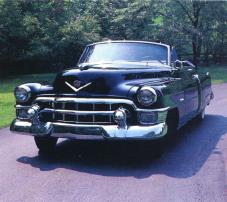
A Coupe DeVille roof pillar script was seen again on this luxury hardtop. Standard equipment included all items featured the year before. Late in the production year the limited-edition Eldorado luxury convertible was added to this model range. A full assortment of Deluxe accessories, including wire wheels, were standard on this specialty car which introduced the wraparound windshield for production models. On August 12, a fire at the Hydra-Matic transmission factory in Livonia, Mich. broke out and would bring a damaging halt to production within a week. It was September 8 before Cadillac’s began leaving the factory again.

I. D. NUMBERS |
- Serial numbers and engine numbers were again one and the same.
- They appeared on the right hand side of the crankcase above the water pump and on the right frame side bar behind the engine support.
- The first two symbols were "53" for 1953.
- The next two symbols indicated the series as follows:
- "62" = Series 62 (including Eldorado)
- "60" = Series Sixty Special Fleetwood
- "75" = Series 75 Fleetwood
- The remaining digits represented the consecutive unit number and began with 00000 for all series.
- All series had the same ending number, which would be misinterpreted if listed.
Model Number | Body Style | Doors | Model | Seating | Factory Price | Shipping Weight | Production Total |
| 53-62 | 6219(X) | 4-door | Sedan | 5 | 3666 | 4201 | 47,316 |
| 53-62 | 6219(X) | 4-door | Sedan | 5 | 3666 | 4201 | 324 |
| 53-62 | 6237(X) | 2-door | Coupe | 5 | 3571 | 4189 | 14,353 |
| 53-62 | 6237DX | 2-door | Coupe DeVille | 5 | 3995 | 4252 | 14,550 |
| 53-62 | 6267X | 2-door | Convertible Coupe | 5 | 4144 | 4476 | 8,367 |
| 53-62 | 62 | - | Chassis only | - | - | - | 4 |
| ELDORADO SPECIAL | |||||||
| 53-62 | 6267SX | 2-door | Sport Convertible Coupe | 5 | 7750 | 4799 | 532 |
NOTES:
- The export sedan was shipped in CKD form to foreign countries.
- The symbol X in brackets indicates hydraulic window lifts optional
- without brackets indicates this feature standard.
ENGINE |
- V-8 Overhead valves.
- Cast iron block.
- Displacement: 331 cubic inches.
- Bore and stroke: 3-15/16 x 3-5/8 inches.
- Compression ratio: 8.25:1.
- Brake horsepower: 210 at 4150 rpm
- Five main bearings
- Hydraulic valve lifters.
- Carburetors:
- with Hydra-Matic Transmission: Carter WCFB four-barrel Model 2005S - also - Rochester 4GC four-barrel Model 7005100.
- with Dynaflow Transmission: Carter WCFB four-barrel Models 2088S, 2119S, and 2119SA also - Rochester 4GC four-barrel Model 7006215.
- Note: After the Hydra-Matic plant fire approximately 19,000 Cadillac’s were sold with Buick Dynaflow transmission attachments. This was referred to as the "Twin Turbine" drive.
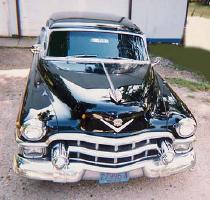
CHASSIS |
- Wheelbase: 126 inches
- Overall length (Sedan): 215.8 inches
- Overall length (Other): 220.8 inches
- Tires: 8.00 x 15.
- Dual exhaust system standard.
- Rear axle ratios: 3.07:1
POWERTRAIN OPTIONS |
- None available.

CONVENIENCE OPTIONS |
- Hydraulic window lifts optional on some Series 62 models.
- Heating and ventilation system ($199).
- Power steering ($177).
- Signal-seeking radio with pre-selector and antenna ($132).
- Remote control signal-seeking radio with pres-elector and antenna ($214).
- Five white sidewall tires ($48 exchange).

- Tinted E-Z-Eye glass ($46).
- Autronic Eye Automatic headlamp beam control ($53).
- Chrome wire wheels ($325).
- Air conditioning ($620).
- Other standard G.M. accessories.
HISTORICAL |
1952 Cadillac
- Details
- Written by Big Block
- Category: 1950-1959
- Hits: 2969
1952 Cadillac

| SERIES 62 |
This was Cadillac's fiftieth anniversary year. Only minor styling and trim changes were seen, but some were specially planned to commemorate the occasion. For example, the V-shaped hood and deck emblems were done as gold castings. The Series 62 sedan was also characterized by a distinct, higher rear deck lid contour. This provided additional luggage space. Backup lights were standard equipment and were now incorporated in the taillights. The grille wraparound panels were redesigned once again. They now had broad chrome trim below each headlight with side scoop styling and a gold-colored winged emblem mounted in the center. At the rear, all models adopted a new Cadillac trademark, a through-the-bumper dual exhaust system. Deck ornamentation varied by series and, on 62s, took the form of a Cadillac crest over a broad golden 'V'. The Coupe DeVille again had a script nameplate on the rear roof pillar. New standards included self-winding clocks, dual-range Hydra-Matic drive, improved direction signal indicators, glare-proof mirrors, stannate treated pistons, four-barrel carburetion and all other features seen the year before. Hydraulic window lifts remained as regular equipment on convertibles and Coupe DeVille’s.
| I. D. NUMBERS |
- Serial numbers and engine numbers were again one and the same.
- They appeared on the righthand side of the crankcase above the water pump and on the right frame side bar behind the engine support.
- The first two symbols were '52- or 1952.
- The next two symbols indicated the series as follows: '62', '60S' or '75'.
- The remaining digits represented the consecutive unit number and began with 00000 for all series.
- All series had the same ending number, which would be misinterpreted if listed.
| Model Number | Body Style | Doors | Model | Seating | Factory Price | Shipping Weight | Production Total |
| 52-62 | 6219 | 4-door | Sedan | 5 | 3636 | 4151 | 42,625 |
| 52-62 | 6237 | 2-door | Club Coupe | 5 | 3542 | 4174 | 10,065 |
| 52-62 | - | 6237DX | Coupe DeVille | 5 | 3962 | 4205 | 11,165 |
| 52-62 | - | 6267X | Convertible Coupe | 5 | 4110 | 4419 | 6,400 |
| ENGINE |
- V-8 Overhead valves.
- Cast iron block.
- Displacement: 331 cubic inches.
- Bore and stroke: 3-13/16 x 3-5/8 inches
- Compression ratio: 7.50:1.
- Horsepower: 190 at 4000 rpm Five main bearings.
- Hydraulic valve lifters.
- Carburetor: Carter WFCB four-barrel Model 896S - also - Rochester 4GC four-barrel 7004500.
| SERIES SIXTY SPECIAL FLEETWOOD |
The Sixty Special Fleetwood sedan had the same general styling changes seen in other lines, plus minor trim and appointment variations. For example, the word Fleetwood appeared on the rear deck lid (instead of a Cadillac crest) and the eight vertical fender louvers were seen again. Hydra-Matic drive and hydraulic windows were installed at no extra cost to buyers.
| Model Number | Body Style | Doors | Model | Seating | Factory Price | Shipping Weight | Production Total |
| 52-60 | 6019 | 4-door | Sedan | 5 | 4720 | 4258 | 16,110 |
| ENGINE |
- V-8 Overhead valves.
- Cast iron block.
- Displacement: 331 cubic inches.
- Bore and stroke: 3-13/16 x 3-5/8 inches
- Compression ratio: 7.50:1.
- Horsepower: 190 at 4000 rpm Five main bearings.
- Hydraulic valve lifters.
- Carburetor: Carter WFCB four-barrel Model 896S - also - Rochester 4GC four-barrel 7004500.
| SERIES 75 FLEETWOOD |
Styling changes on the long-wheelbase series also conformed to the theme for the year with the Golden Anniversary aspect highlighted. Equipment features were the same as before and no business sedans were built.
| Model Number | Body Style | Doors | Model | Seating | Factory Price | Shipping Weight | Production Total |
| 52-75 | 7523X | 4-door | Sedan | 5 | 5361 | 4699 | 1,400 |
| 52-75 | 7533X | 4-door | Imperial Sedan | 8 | 5572 | 4734 | 800 |
| 52-76 | 86 | - | Commercial chassis | - | - | - | 1,694 |
NOTE: The commercial chassis was built off a 157 inch wheelbase and was provided to makers of professional vehicles for construction of funeral cars, ambulances, etc.
| CHASSIS |
| Model | Wheelbase | Overall Length | Front Tread | Rear Tread | Tires |
| Series 62 Sedans | 126 inches | 215-1/2 inches | 59 inches | 63 inches | 8.00 x 15 |
| Series 62 (all others) | 126 inches | 200-1/2 inches | 59 inches | 63 inches | 8.00 x 15 |
| Series 60S | 130 inches | 224-1/2 inches | 59 inches | 63 inches | 8.00 x 15 |
| Series 75 | 147 inches | 236-1/4 inches | 59 inches | 63 inches | 8.20 x 15 |
- Dual exhausts standard.
- Real axle ratio: 3.07:1.
| POWERTRAIN OPTIONS |
- None available.
| CONVENIENCE OPTIONS |
- Hydra-Matic drive on Series 75 ($186).
- Wheel discs ($28).
- Windshield washer ($11).
- Oil filter ($11).
- Fog lamps ($37).
- License frames ($4).
- Outside mirror ($6).
- Vanity mirror ($2).
- E-Z-Eye glass ($46).
- Heater and blower ($114).
- Pushbutton radio and rear speaker ($112).
- Signal-seeking radio and rear speaker ($129).
- Power steering ($198).
- Autronic Eye headlight beam control ($53).
- White sidewall tires Series 62 and 60S ($34).
- Automatic window regulators ($139).
- Wheel trim rings ($11).
| HISTORICAL |
- Cadillac had the most powerful car in the American industry this year.
- The 1,300,000th Cadillac of all time was built.
- Military orders for T41El Walker Bulldog tanks and T41 twin 40-mm gun motor carriages were secured by the Division this year as part of the Korean war buildup.
- Hydraulically controlled power seats were standard on Coupe DeVille.
1951 Cadillac
- Details
- Written by Big Block
- Category: 1950-1959
- Hits: 4475
1951 Cadillac
Although Cadillac styling ultimately drifted to chrome-laden glitter, reaching a low point with the 1958-59 models, the basic 1948 tail finned design, inspired by wartime aircraft and originated by Franklin Q. Hershey under the watchful eye of GM design director Harley Earl, was good enough to remain largely intact through 1953. This was no real surprise. As Cadillac styling chief Bill Mitchell noted: "A traditional look is always preserved. If a grille is changed, the tail end is left alone; if a fin is changed, the grille is not monkey’d with."
And so it was: a new one-piece windshield, revamped grille, and a somewhat bulkier lower-body look for '50; small auxiliary grilles under the headlamps for '51; a winged badge in that spot for '52; one-piece rear windows and suggestive "Dagmar" bumper bullets for '53.
Otherwise, the Cadillac lineup didn't change much in this period. Still accounting for most sales, the Series 62 offered four-door sedan, pillared coupe, pillar less Coupe de Ville, and convertible, all on the usual 126-inch wheelbase. The familiar Sixty Special continued as a solitary super-luxury sedan on its own 130-inch platform (versus 133 inches in the Forties), while the Series 75 continued its traditional array of limousines and long owner-driver sedans on a 146.8-inch chassis. The Series 61, still the "entry-level" Caddy, was demoted to a 122-inch wheelbase (from 126), but again offered a sedan plus newly styled de Ville-inspired pillared coupe. Manual shift was standard on 61s, which were otherwise identical to 62s except for chrome rocker moldings and slightly plainer interiors. Cadillac also continued supplying chassis for various coachbuilders, averaging about 2000 units per year through 1959.
The division really didn't need a "price leader" anymore, so the 61s were dropped after 1951, never to return. Rival Packard, meantime, was still pushing cars priced up to $750 less than the Series 61s, a mistake that Packard didn't fully realize until too late.
| SERIES 61 |
- handbrake warning lamp
- key start ignition
- steering column cover
- Delco-Remy generator
- knee-action front suspension
- directional’s
- mechanical fuel pump
- dual downdraft carburetion
- slipper type pistons
- rubber engine mountings
- oversize brakes
- Super Cushion tires
- one-piece windshield
- intake silencer
- 160 horsepower engine
- oil bath air cleaner
- equalized manifolding
- automatic choke
- luxury appointments.
On the dashboard, "idiot lights" were used to monitor oil pressure and electrical charge rate instead of gauges. The smaller body was again used on 61s and again identified by the lack of full-length chrome underscores. However, a new medallion now appeared on the rear roof pillar of these cars, above the upper beltline molding.
| I. D. NUMBERS |
- Cadillac serial numbers again matched motor numbers and were used for all license, insurance and identification purposes.
- They were located on a boss at the front right hand face of the engine block and on the right frame side member behind the motor support.
- Motor serial numbers for 1951 Series 61 models began at 51610000000.
- The ending number for all Cadillac series was 110340 (preceded by applicable model year and-series code for final unit.)
| Model Number | Body Style | Doors | Model | Seating | Factory Price | Shipping Weight | Production Total |
| 51-61 | 6169 | 4-door | Sedan | 5 | 2917 | 3827 | 2300 |
| 51-51 | 6137 | 2-door | Club Coupe | 5 | 2810 | 3829 | 2400 |
| ENGINE |
- V-8, Overhead valves.
- Cast iron block.
- Displacement: 331 cubic inches.
- Bore and stroke: 3-3/16 x 3-5/8 inches.
- Compression ratio: 7.50:1.
- Brake horsepower: 160 at 3800 rpm
- Five main bearings.
- Hydraulic valve lifters.
- Carburetor: Carter WCD two-barrel Model 845S - also - Rochester BB two-barrel Model 7004200.
| SERIES 62 |
Series 62 models had full-length chrome underscores on the rocker panels, rear fender skirts and lower rear quarters. The sedan had a conventional backlight (i.e., rear window) and featured rear ventipanes. A new Coupe DeVille script was seen on the rear roof pillar of this model which, like the convertible, was an exclusive Series 62 offering. The script clearly distinguished the more luxurious DeVille from the plainer club coupe, a distinction not emphasized in 1950. Hydra-Matic drive was regular equipment on all models (with a new type dial) and power windows were standard on the convertible and Coupe DeVille.
| I. D. NUMBERS |
- Motor serial numbers 516200000 and up appeared on 1951
| Model Number | Body Style | Doors | Model | Seating | Factory Price | Shipping Weight | Production Total |
| 51-62 | 6219 | 4-door | Sedan | 5 | 3528 | 4102 | 54,596 |
| 51-62 | 6219 | - | Export Sedan | 5 | - | - | 756 |
| 51-62 | 6237 | 2-door | Club Coupe | 5 | 3436 | 3993 | 10,132 |
| 51-62 | 6237DX | - | Coupe DeVille | 5 | 3843 | 4074 | 10,241 |
| 51-62 | 6267 | - | Convertible Coupe | 5 | 3987 | 4316 | 6,117 |
| 51-62 | 126 | - | Chassis only | - | - | - | 2 |
NOTE: The export sedan was shipped in completely-knocked-down (CKD) form to foreign countries.
| ENGINE |
- V-8, Overhead valves.
- Cast iron block.
- Displacement: 331 cubic inches.
- Bore and stroke: 3-3/16 x 3-5/8 inches.
- Compression ratio: 7.50:1.
- Brake horsepower: 160 at 3800 rpm
- Five main bearings.
- Hydraulic valve lifters.
- Carburetor: Carter WCD two-barrel Model 845S - also - Rochester BB two-barrel Model 7004200.
| SERIES 60 SPECIAL FLEETWOOD |
The 60 Special Fleetwood sedan was face lifted to conform with the minor changes in other models. Eight vertical chrome louvers on the forward edge of the rear fenders continued to identify this car. All 1951 Cadillac’s with full wheel discs featured a new type design lacking the popular Sombrero look. Hydra-Matic and power windows were standard on Sixty Specials.
| I. D. NUMBERS |
- Motor serial numbers 516000000 and up appeared on 1951 Series 60S models.
| Model Number | Body Style | Doors | Model | Seating | Factory Price | Shipping Weight | Production Total |
| 51-60 | 6019 | 4-door | Sedan | 5 | 4142 | 4136 | 18,631 |
| ENGINE |
- V-8, Overhead valves.
- Cast iron block.
- Displacement: 331 cubic inches.
- Bore and stroke: 3-3/16 x 3-5/8 inches.
- Compression ratio: 7.50:1.
- Brake horsepower: 160 at 3800 rpm
- Five main bearings.
- Hydraulic valve lifters.
- Carburetor: Carter WCD two-barrel Model 845S - also - Rochester BB two-barrel Model 7004200.
| SERIES 75 FLEETWOOD |
The Series 75 Fleetwood models were also face lifted to conform to the minor changes seen in other lines. Jump seats were used in both the seven-passenger sedan and Imperial limousine. Hydra-Matic drive was optional and hydraulic window lifts were standard. Business sedans were built in limited numbers on a special order basis.
| I. D. NUMBERS |
- Motor serial numbers 517500000 and up appeared on 1951 Series 75 Fleetwood models.
| Model Number | Body Style | Doors | Model | Seating | Factory Price | Shipping Weight | Production Total |
| 51-75 | 7523X | 4-door | Sedan | 8 | 5200 | 4555 | 1,090 |
| 51-75 | 7533X | 4-door | Imperial Sedan | 8 | 5405 | 4586 | 1,085 |
| 51-75 | 7523L | 4-door | Business Sedan | 8 | - | - | 30 |
| 51-75 | 86 | - | Commercial chassis | - | - | - | 2,960 |
NOTE: The commercial chassis featured a 157 inch wheelbase and was supplied to professional car makers for construction.
| ENGINE |
- V-8, Overhead valves.
- Cast iron block.
- Displacement: 331 cubic inches.
- Bore and stroke: 3-3/16 x 3-5/8 inches.
- Compression ratio: 7.50:1.
- Brake horsepower: 160 at 3800 rpm
- Five main bearings.
- Hydraulic valve lifters.
- Carburetor: Carter WCD two-barrel Model 845S - also - Rochester BB two-barrel Model 7004200.
| CHASSIS |
| Model | Wheelbase | Overall Length | Front Tread | Rear Tread | Tires |
| Series 61 | 122 inches | 211-7/8 | 59 inches | 63 inches | 8.00 x 15 |
| Series 62 | 126 inches | 225-7/8 | 59 inches | 63 inches | 8.00 x 15 |
| Series 60S | 130 inches | 224-7/8 | 59 inches | 63 inches | 8.00 x 15 |
| Series 75 | 146-3/4 inches | 236-5/8 | 59 inches | 63 inches | 8.20 x 15 |
| POWERTRAIN OPTIONS |
- None available.
| CONVENIENCE OPTIONS |
- Hydra-Matic drive on Series 61 and 75 ($186).
- Power windows (specific models).
- Heating and ventilating system.
- Radio and antenna.
- Chrome wheel discs.
- Windshield washers.
- Fog lamps.
- White sidewall tires (availability limited).
| HISTORICAL |
- The Series 61 line was discontinued in the middle of the year due to lagging sales.
1950 Cadillac
- Details
- Written by Big Block
- Category: 1950-1959
- Hits: 2661
1950 Cadillac
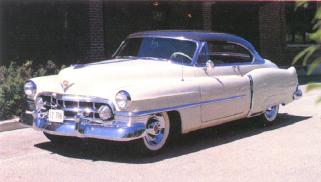 Cadillac began reaching for U.S. luxury-car leadership in the Thirties, and clinched it for good in the Fifties. Symbolizing its achievement was the 1958 death of Packard, once America's premier prestige make, due to an over-long reliance on medium-price products and a crippling 1954 merger with troubled Studebaker. Lincoln would never threaten Cadillac's supremacy in the Fifties, owing to a more limited lineup. Nor would Chrysler, even after spinning off Imperial as a separate make after 1954.
Cadillac began reaching for U.S. luxury-car leadership in the Thirties, and clinched it for good in the Fifties. Symbolizing its achievement was the 1958 death of Packard, once America's premier prestige make, due to an over-long reliance on medium-price products and a crippling 1954 merger with troubled Studebaker. Lincoln would never threaten Cadillac's supremacy in the Fifties, owing to a more limited lineup. Nor would Chrysler, even after spinning off Imperial as a separate make after 1954.
Several developments in the Forties laid the foundation for Cadillac's high Fifties success. First, the division returned to prestige cars exclusively after 1940, abandoning its medium-price LaSalle once the luxury market recovered from its Depression-era doldrums. 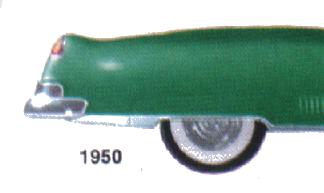 Then Cadillac landed a formidable one-two postwar punch: tailfin styling for '48, followed by a landmark new overhead-valve V-8 for 1949, when the division also pioneered (with Olds and Buick) the instantly popular new hardtop convertible body style. About all Cadillac needed in the Fifties were styling and features that pleased most buyers most of the time, which it delivered.
Then Cadillac landed a formidable one-two postwar punch: tailfin styling for '48, followed by a landmark new overhead-valve V-8 for 1949, when the division also pioneered (with Olds and Buick) the instantly popular new hardtop convertible body style. About all Cadillac needed in the Fifties were styling and features that pleased most buyers most of the time, which it delivered.
Initially sized at 331 cubic inches, the Cadillac V-8 was the product of 10 years research and experimentation. It was mainly engineered by Ed Cole, Jack Gordon, and Harry Barr, who aimed for less weight and higher compression (to take advantage of the higher-octane fuels promised after the war). These factors dictated the overhead valve arrangement, a stroke shorter than bore (3.63 inches, versus 3.81), compact wedge-shape combustion chambers, and "slipper" pistons. The last, developed by Byron Ellis, traveled low between the crankshaft counterweights, allowing for short connecting rods and low reciprocating mass.
With all these advantages, the ohv arrived with 160 bhp, 10 more than Cadillac's last 346 L-head V-8 -- and from less displacement, testifying to its efficiency. The ohv had other advantages. Though built of cast iron, like the L-head, it weighed nearly 200 pounds less, yet would prove just as durable and reliable. Initial compression was only 7.5:1, yet could be pushed as high as 12:1; the L-head couldn't. The ohv also boasted more torque and 14-percent better fuel economy. Equally important, it had room enough to be greatly enlarged -- as it soon was.

This superb engine combined with a surprisingly competent chassis to make early-Fifties Cadillac’s some of the best road cars of that day. Chicago enthusiast Ed Gaylord, who backed the short-lived Gaylord car of mid-decade, owned a 1950 Series 61 with standard shift and 3.77 rear axle. He also had a new Jaguar XK-120 at the time. Gaylord later said that "the Cadillac was the faster car up to about 90 mph. [It also] set what was then a stock-car record at the original quarter-mile drag races in Santa Ana, California .... The only competition I had in acceleration was from the small 135-horsepower Olds 88 coupe, but the Cadillac engine was substantially more efficient both in performance and economy." Indeed, such a car could clock 0-60 mph in around 13 seconds and easily top 100 mph.

Further proof of the V-8's prowess was provided by sportsman Briggs Cunningham, who entered a near-stock 1950 Cadillac in that year's 24 Hours of Le Mans in France. Driven by Sam and Miles Collier, it finished 10th overall -- a performance unmatched by any other production luxury car -- tearing down the Mulsanne Straight at around 120 mph and averaging 81.5 mph for the entire event. Cunningham himself drove a streamlined Cadillac-powered special that the French called Le Monstre. He went even faster than the Colliers, but lost top gear and finished right behind them. Perhaps most impressive, a British-built Allard J2, powered by the same Cadillac V-8, finished third.
Of course, such exploits mattered less in showrooms than the smooth, powerful V-8 itself. And Cadillac had another advantage going into the Fifties: GM's equally smooth and efficient self-shift Hydra-Matic Drive, by then standard on all models except the low-priced Series 61. Together with the V-8, it made for luxury-car performance demonstrably superior to that of rival heavyweights with less vigorous drive trains. Though the V-8 would remain at 331 cid through 1955, it gained over 100 bhp in the interim, reaching 270 on that year's Eldorado.
Prices for the 1950 line started at $2761 for the Series 61 coupe (although few models went for under $3000) and reached up to about $5000 for a 75 sedan or limo. The 61s cost about $575 less than comparable 62s. Division sales topped 100,000 for 1950.
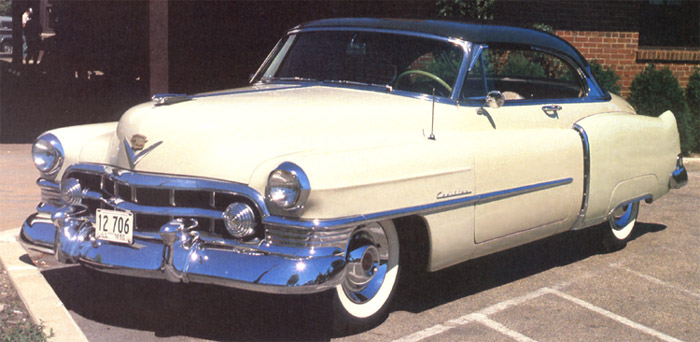
Alas, Cadillac styling ultimately drifted to chrome-laden glitter, reaching a low point with the 1958-59 models. But the basic 1948 tail finned design, inspired by wartime aircraft and originated by Franklin Q. Hershey under the watchful eye of GM design director Harley Earl, was good enough to remain largely intact through 1953. A fairly important change is that, unlike sister GM divisions, Cadillac completely abandoned Forties-style fastbacks for 1950, switching pillared coupes to notchback profiles with hardtop-type rooflines inspired by the successful 1949 Coupe de Ville.
| SERIES 61 |
Cadillac’s had extensive styling changes this year. They looked generally heavier and had low, sleek contours with longer rear decks, more sweeping front fenders and a broken rear fender line. The hood protruded further out at the front and was underlined by an even more massive egg crate grille. Round parking lights were used, but as in the past, when buyers chose fog lamps an additional bulb and larger housing were used. This setup combined the fog lamps and directional signals. One-piece windshields were introduced and the leading edge of the rear fenders, which had a broken-off look, was highlighted by chrome imitation air slots. The rear fenders were longer and ended in a swooping tailfin design. A Cadillac script again appeared on the sides of front fenders, but was now positioned closer to the front door opening gap. As far as Series 61 models went, a big styling change was a return to marketing this line on a shorter wheelbase than used on the 62s. This led to some styling differences. For example, the Series 61 sedan had no rear ventipanes and featured a wraparound backlight (i.e., rear window). An identifying feature on both models was the absence of rocker panel moldings and rear quarter panel chrome underscores. Cars in Cadillac's lowest-priced range also had bodies which were four inches shorter than the previous season.
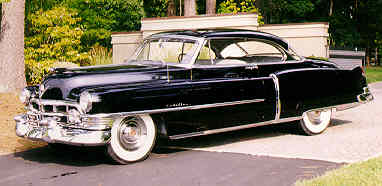
| I. D. NUMBERS |
- Cadillac serial numbers again matched motor numbers and were used for all license, insurance and identification purposes.
- They were located on a boss on the right hand face of the engine block and on the right frame side member behind the motor support.
- Motor serial numbers 506100000 to 5061103853 appeared on 1950 Series 61 models.
| Model Number | Body Style | Doors | Model | Seating | Factory Price | Shipping Weight | Production Total |
| 50-61 | 6169 | 4-door | Sedan | 5 | 2866 | 3822 | 14,619 |
| 50-61 | 6137 | 2-door | Club Coupe | 5 | 2761 | 3829 | 11,839 |
| 50-61 | 6169 | - | Export Sedan | 5 | 2866 | 3822 | 312 |
| 50-61 | - | - | Chassis only | - | - | - | 2 |
NOTE: The sedan for export was shipped in a completely-knocked-down (CKD) form to foreign countries.
| ENGINE |
- V-8 Overhead valves.
- Cast iron block.
- Displacement: 331 cubic inches.
- Bore and stroke: 3-3/16 x 3-5/8 inches.
- Compression ratio: 7.50:1.
- Brake horsepower: 160 at 3800 rpm
- Five main bearings.
- Hydraulic valve lifters.
- Carburetor: Carter WCD two-barrel Model 742S.
| SERIES 62 |
Cars in the Cadillac next-step-up line were identified by slightly richer interior appointments and by chrome underscores running the full length of the body at the bottom. Hydra-Matic drive was now standard in this line. The Series 62 sedan incorporated rear ventipanes. Exclusive models in this range were the convertible coupe and Coupe DeVille, both with standard hydraulic window lifts.
| I. D. NUMBERS |
- Motor serial numbers 506200000 to 5062103857 appeared on 1950 Series 62 models.
| Model Number | Body Style | Doors | Model | Seating | Factory Price | Shipping Weight | Production Total |
| 50-62 | 6219 | 4-door | Sedan | 5 | 3234 | 4012 | 4 1,890 |
| 50-62 | 6237 | 2-door | Club Coupe | 5 | 3150 | 3993 | 6,434 |
| 50-62 | 6237DX | - | Coupe DeVille | 5 | 3523 | 4074 | 4,507 |
| 50-62 | 6267 | - | Conv Coupe | 5 | 3654 | 4316 | 6,986 |
| 50-62 | - | - | Chassis only | - | - | - | 1 |
| ENGINE |
- V-8 Overhead valves.
- Cast iron block.
- Displacement: 331 cubic inches.
- Bore and stroke: 3-3/16 x 3-5/8 inches.
- Compression ratio: 7.50:1.
- Brake horsepower: 160 at 3800 rpm
- Five main bearings.
- Hydraulic valve lifters.
- Carburetor: Carter WCD two-barrel Model 742S.
| SERIES 60 SPECIAL FLEETWOOD |
| I. D. NUMBERS |
- Motor serial numbers 506000000 to 5060103850 appeared on 1950 Series 60S models.
| ENGINE |
- V-8 Overhead valves.
- Cast iron block.
- Displacement: 331 cubic inches.
- Bore and stroke: 3-3/16 x 3-5/8 inches.
- Compression ratio: 7.50:1.
- Brake horsepower: 160 at 3800 rpm
- Five main bearings.
- Hydraulic valve lifters.
- Carburetor: Carter WCD two-barrel Model 742S.
| SERIES 75 FLEETWOOD |
| I. D. NUMBERS |
Motor serial numbers 507500000 to 507510387 were used on 1950 Series 75 Fleetwood models.
| Model Number | Body Style | Doors | Model | Seating | Factory Price | Shipping Weight | Production Total |
| 50-75 | 7523X | 4-door | Sedan | 7 | 4770 | 4555 | 716 |
| 50-75 | 7533X | 4-door | Imperial Sedan | 7 | 4959 | 4586 | 743 |
| 50-75 | 7523L | 4-door | Business Sedan | 7 | - | - | 1 |
| 50-75 | 86 | - | Commercial chassis | - | - | - | 2,052 |
NOTE: The commercial chassis featured a 157 inch wheelbase and was supplied to professional car makers for the construction of funeral cars, ambulances, etc.
| ENGINE |
- V-8 Overhead valves.
- Cast iron block.
- Displacement: 331 cubic inches.
- Bore and stroke: 3-3/16 x 3-5/8 inches.
- Compression ratio: 7.50:1.
- Brake horsepower: 160 at 3800 rpm
- Five main bearings.
- Hydraulic valve lifters.
- Carburetor: Carter WCD two-barrel Model 742S.
| CHASSIS |
| Model | Wheelbase | Overall length | Front Tread | Rear Tread | Tires |
| Series 61 | 122 inches | 211-7/8 | 59 inches | 63 inches | 8.00 x 15 |
| Series 62 | 126 inches | 215-7/8 | 59 inches | 63 inches | 8.00 x 15 |
| Series 60S | 130 inches | 224-7/8 | 59 inches | 63 inches | 8.00 x 15 |
| Series 75 | 146-3/4 inches | 236-5/8 | 59 inches | 63 inches | 8.20 x 15 |
| POWER TRAIN OPTIONS |
- None available.
| CONVENIENCE OPTIONS |
- Hydra-Matic drive on Series 61 and 75 ($174).
- Power windows (on specific models).
- Heating and ventilating system.
- Radio and antenna.
- Chrome wheel discs (Sombrero).
- Windshield washers.
- Fog lamps.
- White sidewall tires.
- Other standard accessories.
| HISTORICAL |
- Stainless steel Sombrero wheel covers replaced the chrome plated type this year, although the stampings were identical.
- An hydraulic seat was standard on the Coupe DeVille.
- The one-millionth Cadillac ever produced was a 1950 Coupe DeVille assembled Nov. 25, 1949.
- An all-time Cadillac production record was also established this season.